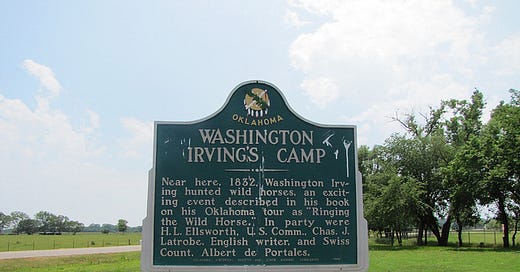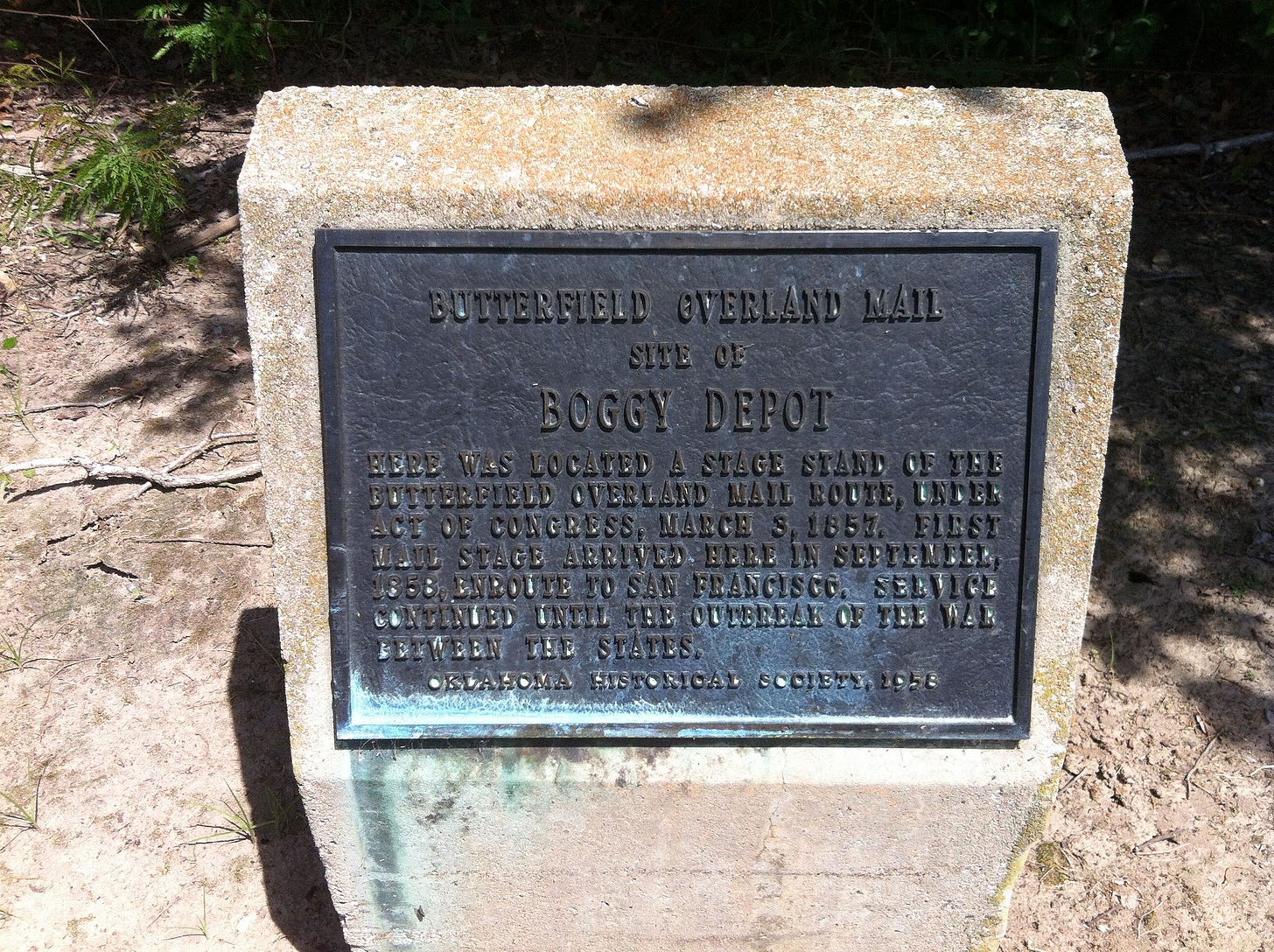Historical Markers
These old signs you'll find along Oklahoma's highways only give you a glimpse at the history they represent.
I published this as Blog Oklahoma Podcast: Episode 44, Historical Markers on January 20, 2017. I’ve updated it with some links and photos, but the text remains unchanged. - K.
Historical Markers
I've been going around the state for many years, visiting as many Oklahoma historical markers as I can. It's been a real pleasure learning all these fascinating bits of Oklahoma's rich history. Many of these historical markers were put up decades ago. I'm not sure when the earliest historical marker was placed, in fact, that's something I've been meaning to research. Needless to say, these markers can be quite old. It's amazing how many of the green metal signs and small metal placards have survived in actual good condition to today. Some are better than others, of course. The restoration and recovery of some of these historical markers, that haven't survived so well, is a discussion we as a State should be having, but I'm going to table that for a bit. No what I want to talk about today is what is told on these historical markers.
These old signs you'll find along Oklahoma's highways only give you a glimpse at the history they represent. In some cases, they show less than a summary and instead only give you a few select bullet points. The reason is they were trying to give you as much of the important historical information as they could in the small space the sign will allow. Some of the modern large granite historical monuments provide much more information. They can fit whole paragraphs of history on them, but still, they will leave some stuff out for the same reason: space.
To put these green metal signs it in modern terms, imagine having to describe an historical event on Twitter and you're only allowed one tweet to do it in. This event you're trying to describe ends up being a few disjointed poorly structured sentences or just a headline. Something along the lines of "Washington Irving Camped Here". That headline does describe quite a bit, but if you have no idea who Washington Irving was, the relevance of the historical marker is lost on you.
Now that's a condensed example. The historical marker would actually say something more along the lines of "Washington Irving's Camp. Near here, 1832. Washington Irving hunted wild horses, an exciting event described in his book on his Oklahoma tour as "Ringing the Wild Horse." ..." Now that's a bit more descriptive. You now know Washington Irving was an author, when he was here, and what he was doing at this camp.
This is an actual historical marker by the way. It's a green metal sign put up in 1949 along Route 66 near Arcadia, Oklahoma.
So you know a little bit more of the history of this particular location. But again, if you have no idea who Washington Irving was, what book they are talking about, or even why he was in Oklahoma Territory, you're still kind of lost as to why this was important enough for a marker.
Back in 1949 you could have taken a picture of this historical marker, so you could remind yourself to research this later. But you're not going to see that picture again for a while. You'll have to wait until you got home, wait until you finish the roll of film, run down to the drug store (I'm assuming), drop off your film, and then come back in a few weeks when your pictures were finally developed. Now assuming your picture turned out. You still have to do your research, and that meant going down to the library, dig though the card catalog, and maybe, just maybe, your library had a book on or by Washington Irving.
Now today I could magically say "Hey Google, who was Washington Irving?" [clip] And I also can easily find out the book was called "A Tour on the Prairies" It was published in 1835. Is in the public domain, so you can go online, download it, and read it at your leisure. Oh and look for Chapter XXV (25).
So hopefully now you understand why some of these older historical markers don't give you the full history. They will often leave a lot out, and I mean a lot. There are even historical markers out there just note the location of a building or a townsite, and don't go into a whole lot more.
A good example would the small markers that note the stops along the Butterfield Overland Mail route. This was a stagecoach and mail route in the 1850's that cut across Southeastern Indian Territory from Fort Smith, Arkansas down to Colbert's Ferry on the Red River. These are small markers. They are basically a short concrete block just a few feet high with a metal plaque on them. These were put up along the historic route in 1958.
On a side note these particular kind of markers are really hard to find. They are small enough they're hidden by tall grass, and they're mostly site based, meaning you don't find them along the highways like the green metal signs. They are often found on private property and some are just lost to time. If you want to see an example of this type marker and visit one along the Butterfield Overland Mail route there is one in the Boggy Depot Park near Atoka, Oklahoma.
So as I was trying to express these historical markers only give you a touch of the history they represent. They are bookmarks in the big book of Oklahoma history left for you so you can finish reading. And I encourage you to look into the stories and dig deeper. We are in the information age. Learning more about Oklahoma history, about human history, is much easier now than it was for the people who put up that green metal sign for you those decades ago. We know more now. The stories have been added to. We're including more. We're hearing the other side of the story. You'll find Oklahoma's history is full of wonder and adventure, heartache and sorrow, and acts of heroism. You'll read about our best and our worst and you'll learn from the mistakes that were made. That's what this exploration of Oklahoma history does we learn from the past for a better future.
Yeah I know that's kind of cheesy. What can I say I'm passionate about this.
So the next time you see one of those tall granite monuments or green metal signs along the highway, stop. Give it a read and you'll start to wonder. Pull out your phone and ask Google, Siri, or Cortana to tell you more.
You can listen to the original episode of the Blog Oklahoma Podcast below.
For more episodes of the Blog Oklahoma Podcast, please visit blogoklahoma.net.
Feedback Welcome
Please don’t hesitate to contact me with any comments or questions. You can leave a comment on Substack, send me an email, or connect with me on social media at Mastodon, Bluesky, or Threads.
This newsletter is always free; no paid subscription is required. However, if you want to support me with all I do at Blog Oklahoma, you can be a paid subscriber of our Substack newsletter or buy me a coffee on Ko-Fi. It’s really not necessary, but it’s always appreciated. Thank you.
Until next time.
– K. @}-;--
.





